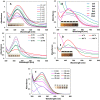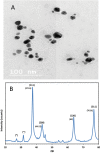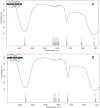Biosynthesis of silver nano-drug using Juniperus excelsa and its synergistic antibacterial activity against multidrug-resistant bacteria for wound dressing applications
- PMID: 33987072
- PMCID: PMC8105439
- DOI: 10.1007/s13205-021-02782-z
Biosynthesis of silver nano-drug using Juniperus excelsa and its synergistic antibacterial activity against multidrug-resistant bacteria for wound dressing applications
Abstract
We report here the synthesis of silver nanoparticles (AgNPs) from an aqueous extract of Juniperus excelsa and their use as an antimicrobial agent on their own or in combination with antibiotics in inhibiting multidrug-resistant bacteria (MDR). One strategy of bacterial infection control in wound healing is AgNP biosynthesis. We collected bacterial strains of patient skin infections from Al-Adwani Hospital. Phenotyping, biotyping, and molecular characterizations were applied using 16S rRNA gene analysis of bacterial isolates. Our results identified tested MDR bacteria Staphylococcus aureus strains (methicillin-resistant and methicillin-susceptible) and Proteus mirabilis. Gas chromatography/mass spectrometry (GC/MS) analysis was used to identify the Juniperus excelsa biomolecules in the leaf extract acting as both reducing and capping agents in the biosynthesis of AgNPs. The AgNPs appeared hexagonal and spherical in shape upon transmission electron microscope (TEM) analysis. The AgNP sizes ranged from 16.08 to 24.42 nm. X-ray diffraction (XRD) analysis confirmed the crystalline nature of the particles. The minimum inhibitory concentrations (MICs) of the AgNPs against the tested MDR bacteria ranged from 48 to 56 µg/ml, while the minimum bactericidal concentrations (MBCs) of the AgNPs against the tested strains ranged from 72 to 96 µg/ml. The AgNPs showed a good synergistic efficacy with Cefaclor, Cefoxitin, and Erythromycin. Their efficiency showed a threefold increase in the inhibition of tested strains when used in wound dressing, due to the AgNPs potentially activating the antibiotics. Consequently, we can use AgNPs with Cefaclor, Cefoxitin, and Erythromycin antibiotics as alternative antimicrobial agents, and they could be utilized in wound dressing to prevent microbial infections.
Keywords: Antibiotic resistance; Silver nanoparticles; Synergistic effect; Wound dressing.
© King Abdulaziz City for Science and Technology 2021.
Conflict of interest statement
Conflict of interestThe authors declare that they have no conflict of interest in the publication.
Figures








Similar articles
-
Biosynthesis of silver nanoparticles using Myristica fragrans seed (nutmeg) extract and its antibacterial activity against multidrug-resistant (MDR) Salmonella enterica serovar Typhi isolates.Environ Sci Pollut Res Int. 2017 Jun;24(17):14758-14769. doi: 10.1007/s11356-017-9065-7. Epub 2017 May 3. Environ Sci Pollut Res Int. 2017. PMID: 28470497
-
Synthesis of Silver Nanoparticles from Extracts of Wild Ginger (Zingiber zerumbet) with Antibacterial Activity against Selective Multidrug Resistant Oral Bacteria.Molecules. 2022 Mar 21;27(6):2007. doi: 10.3390/molecules27062007. Molecules. 2022. PMID: 35335369 Free PMC article.
-
Antibacterial activities of hexadecanoic acid methyl ester and green-synthesized silver nanoparticles against multidrug-resistant bacteria.J Basic Microbiol. 2021 Jun;61(6):557-568. doi: 10.1002/jobm.202100061. Epub 2021 Apr 19. J Basic Microbiol. 2021. PMID: 33871873
-
Antibacterial and antibiofilm potential of silver nanoparticles against antibiotic-sensitive and multidrug-resistant Pseudomonas aeruginosa strains.Braz J Microbiol. 2021 Mar;52(1):267-278. doi: 10.1007/s42770-020-00406-x. Epub 2020 Nov 24. Braz J Microbiol. 2021. PMID: 33231865 Free PMC article. Review.
-
Effect of Size, Shape and Surface Functionalization on the Antibacterial Activity of Silver Nanoparticles.J Funct Biomater. 2023 Apr 26;14(5):244. doi: 10.3390/jfb14050244. J Funct Biomater. 2023. PMID: 37233354 Free PMC article. Review.
Cited by
-
Prevalence and Molecular Characterization of Methicillin-Resistant Staphylococcus aureus from Nasal Specimens: Overcoming MRSA with Silver Nanoparticles and Their Applications.J Microbiol Biotechnol. 2022 Dec 28;32(12):1537-1546. doi: 10.4014/jmb.2208.08004. Epub 2022 Nov 1. J Microbiol Biotechnol. 2022. PMID: 36379700 Free PMC article.
-
Green Synthesis of MOF-Mediated pH-Sensitive Nanomaterial AgNPs@ZIF-8 and Its Application in Improving the Antibacterial Performance of AgNPs.Int J Nanomedicine. 2023 Aug 28;18:4857-4870. doi: 10.2147/IJN.S418308. eCollection 2023. Int J Nanomedicine. 2023. PMID: 37662688 Free PMC article.
-
Erythromycin Formulations-A Journey to Advanced Drug Delivery.Pharmaceutics. 2022 Oct 13;14(10):2180. doi: 10.3390/pharmaceutics14102180. Pharmaceutics. 2022. PMID: 36297615 Free PMC article. Review.
-
Microalgae-mediated green synthesis of silver nanoparticles: a sustainable approach using extracellular polymeric substances from Graesiella emersonii KNUA204.Front Microbiol. 2025 May 14;16:1589285. doi: 10.3389/fmicb.2025.1589285. eCollection 2025. Front Microbiol. 2025. PMID: 40438219 Free PMC article.
-
Antimicrobial Efficacy of Glass Ionomer Cement in Incorporation with Biogenic Zingiber officinale Capped Silver-Nanobiotic, Chlorhexidine Diacetate and Lyophilized Miswak.Molecules. 2022 Jan 14;27(2):528. doi: 10.3390/molecules27020528. Molecules. 2022. PMID: 35056835 Free PMC article.
References
-
- Agnihotri S, Mukherji S, Mukherji S. Size-controlled silver nanoparticles synthesized over the range 5–100 nm using the same protocol and their antibacterial efficacy. RSC Adv. 2014;8:3974–3983. doi: 10.1039/C3RA44507K. - DOI
-
- Akram FE, El-Tayeb T, Abou Aisha K, El Azizi M. A combination of silver nanoparticles and visible blue light enhances the antibacterial efficacy of ineffective antibiotics against methicillin-resistant Staphylococcus aureus (MRSA) Ann Clin Microbiol Antimicrob. 2016;15:48. doi: 10.1186/s12941-016-0164-y. - DOI - PMC - PubMed
-
- Al-Anazi AR. Prevalence of methicillin-resistant Staphylococcus aureus in a teaching hospital in Riyadh, Saudi Arabia. Biomed Res. 2009;20:7–14.
-
- Aravinthan A, Govarthanan M, Selvam K, Praburaman L, Selvankumar T, Balamurugan R, Kamala-Kannan S, Kim J. Sunroot mediated synthesis and characterization of silver nanoparticles and evaluation of its antibacterial and rat splenocyte cytotoxic effects. Int J Nanomedicine. 2015;10:1977–1983. doi: 10.2147/IJN.S79106. - DOI - PMC - PubMed
-
- Ashok B, Hariram N, Siengchin S, Rajulu AV. Modification of tamarind fruit shell powder with in situ generated copper nanoparticles by single step hydrothermal method. J Biores Bioprod. 2020;5:180–185. doi: 10.1016/j.jobab.2020.07.003. - DOI
LinkOut - more resources
Full Text Sources
Other Literature Sources
Miscellaneous

